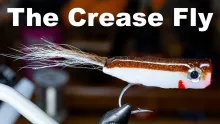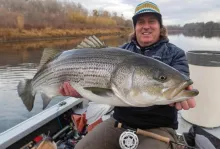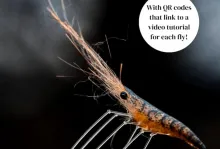Third and last part of fishing guide Roland Henrion's article on fly fishing equipment care and maintenance. This time on the proper treatment and storage of fly lines. Tired of stiff, coiling lines that makes bird's nests?
Part 3
Line care
In part 1 and 2, I explained how to keep rods and reels in good shape and ensure many years of fly fishing enjoyment. Fly lines have a limited life span, but they are an essential piece of equipment in our sport, litterally connecting the angler to the fish. Long, accurate casts with fast, narrow loops are proof of a well chosen, balanced outfit mastered technique. It offers the angler tremendous joy and satisfaction, but in order to achieve this, our fly lines must be kept clean and slick at all times. Again, it takes less effort than you might think.
Fly line & backing care
Fly lines get damaged in various ways, but the most important one is mechanical wear: ripping through the guide rings (especially the tip top), getting trampled on, dragging over coral, or through sand and mud, just to name a few. Then there is also UV radiation, excessive heat and certain chemicals (pollutants in rivers and lakes, suncream, oil, etc).
The leading fly line manufacturers build a lubricant inside the fly line coating. Because the coating is slightly porous, it slowly releases the lubricant, keeping the line slick and floating. Excessive dirt will clog the pores, preventing the lubricant from doing its job and that is why we should keep our lines clean as much as possible.
Left on a small diameter spool (a fly reel for instance) for a long period, our fly line will remain coiled when it comes off the spool. This phenomenon is known as line memory. A pigtailed fly line hampers casting and affects fly delivery and striking.
Without proper care, a fly line will last only one season or less, but we can extend the life of fly lines to several years with a minimum of effort.
Backing hardly needs any maintenance for freshwater fishing, but in saltwater it can get affected by salt, UV radiation and mildew. One of my clients once lost two sailfish due to rotten backing... Yes, that's right, he lost two expensive fly lines as well!
Backing tends to be forgotten and is left on the reel without another thought. Yet it should be frequently inspected for damaged or weak spots (coral head or oyster bank encounters). When drying up, salt crystals can cake backing together. Discover this when that long-hoped-for permit makes a run for the horizon and all you can do is hope and pray...
Some line tips:
- Immediately after fishing, rinse the fly line under a tap, before salt and dirt dry up. Preferably stow on a large arbour, vented spool until the next fishing day.
- At least four times a year and more frequently when fishing in saltwater, fly line and backing should be soaked in hot soapy water for several hours. This will release dirt and salt.
NOTE: do not use washing-up liquid, as this changes the surface tension of the fly line and reduces floatability. Better to use natural hand soap or baby shampoo. - Apply line dressing regularly but sparsely. Be careful with certain silicone based dressings. They can do more harm than good. Always read the manufacturer's recommendations.
- Stretch the line before fishing, it will cast much better.
- Dragging a fly line over rocks, marl, sand, docks and decks damages the finish. If you have to walk some distance, better pick up the flyline in loose coils.
- Try not to trample your line, use a line tray, especially when fishing from rocks, coral or marl.
- Practise casting on a lawn and not on dirt or asphalt.
- Don't leave your fly line exposed to the sun when not in use.
- Store a double taper fly line on a a large arbour,vented spool between fishing sessions instead of on your fly reel. You will be able to reverse it and use the rear taper next season.
- To remove twists and kinks, take off leader and fly and troll the line behind the boat for a few minutes. On a river, just let the line hang in the current. Removal of twists can also be achieved by pulling the flyline between your fingers - always from the rear end towards the front taper. Use a piece of cloth to avoid burned fingers. You might have to repeat the operation several times.
- Damp fly lines and backing in a enclosed environment will get stained and sticky from mildew. It attacks the finish, which results in poor casting and reduced floatability. To prevent mildew on backing and flyline, better to stow it on a large arbour, vented spool.
Catching large fish is often a combination of luck, local knowledge, skill and perseverence. It is ONLY possible with fishing gear in perfect condition. How many specimen fish get away because of failing tackle? Can one honestly call it bad luck?
As a guide, I provided rods and reels to my clients and I couldn't afford to have them loose fish because of poorly maintained tackle.
Once, a French angler lost a fine yellowfin tuna after battling the fish for more than one hour. We thought the tippet broke, but it appeared that he'd spit the fly. To my utter surprise, inspection of the fly revealed the 6/0 stainless steel hook had broken. I felt miserable for my client. After each day on the water, I always rinsed the flies we used and yet, the humidity trapped in the fly's feathers and bucktail fibers had caused the hook to rust unnoticed. That night, I checked all my flies and discarded almost the whole lot. Stainless steel hooks they said? Yeah, right. Today, all my off-shore flies are tube-flies...
So, you'd better keep a close eye on your stuff! It only takes a little effort, but you will save big bucks on tackle and lines. And when the big one strikes, you will be ready for him!
Tight lines!
Don't forget Parts 1 & 3 about Rod and Reel care!
Roland Henrion
Former fishing guide in Seychelles
The Smart Spooler line winder I designed will help maintaining your reels and lines. Check it out on www.smartfisher.com or read the review here on Global FlyFisher
You can read more about line care in Steve Schweitzer's article on the subject and see all our articles about lines here.
- Log in to post comments













I'm trying to find a
I'm trying to find a way to store my fly lines off the reels. Somehow the package spools and boxes disappear. Is there somebody that sells spools ?
great information, o
great information, on line care, as a guide myself, too often i see clients equipment brought on board may be relatively new but in questionable working order, drag, lube neglect, and line neglect, thanks for driving home the importance of equipment care. capt. brian moran
Thank you for some g
Thank you for some good information. I've been thinking about making some kind of large arbor (I''m a little bit of a woodworker), but I've not found a model to work from. Any ideas.
I fish for panfish and bass in Illinois, and occasionly in Minnesota.